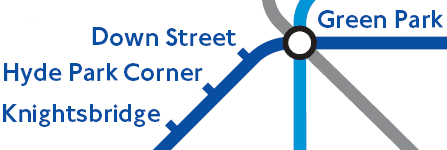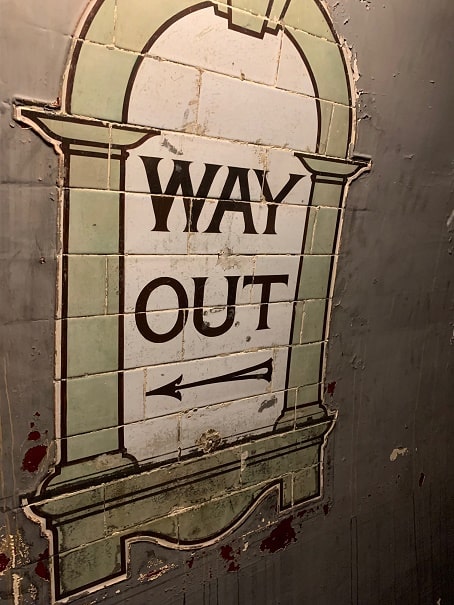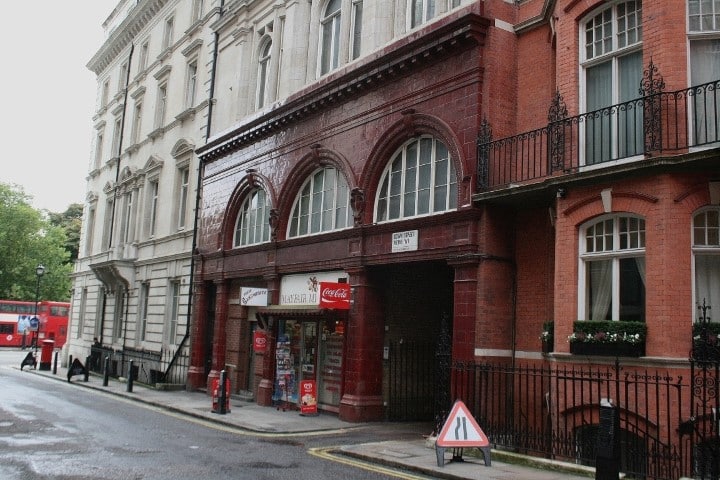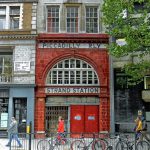Last Updated on 18/04/2023 by Alex Hamlyn
Table of Contents
Where is Down Street Underground Station?
Down Street’s location in Mayfair places it on the Piccadilly Line, which stretches from Heathrow Airport and Uxbridge in the west to Cockfosters in the north. The line connects some of London’s most famous landmarks, such as Buckingham Palace, the British Museum, and the West End theatre district.
Not far from Down Street Station, the nearest active stations are Green Park and Hyde Park Corner, both of which serve the Piccadilly Line as well as other lines.
History of Down Street Station
The labyrinthine network of the London Underground has seen significant changes and expansion over its long history, with numerous stations falling into disuse and being abandoned, often forgotten by time. These abandoned stations, known as “ghost stations,” are intriguing for history buffs and urban explorers alike.
One such fascinating station is Down Street London Underground Station, which holds a unique history that has withstood the test of time. This article delves into the origins, history, and current status of Down Street Station.
When was Down Street Underground Station built?
Down Street Station, located in the affluent Mayfair area of London, opened its doors to the public on March 15, 1907, as part of the Great Northern, Piccadilly, and Brompton Railway (GNP&BR), which later became the Piccadilly Line.
The station was designed by architect Leslie Green, who is well-known for his distinctive Arts and Crafts style and signature oxblood-red terracotta façade. Green designed many stations on the London Underground system, which has made his work iconic and synonymous with the city’s transport network.

Why was Down Street tube station closed?
Despite its location in an upscale neighbourhood, Down Street Tube Station faced several challenges from the outset. The station’s proximity to Green Park and Hyde Park Corner stations—two more popular stations on the Piccadilly Line—meant that passenger numbers were consistently low.
Moreover, the narrow platforms, constrained by the compact nature of the street above, rendered it difficult to accommodate the increasing size of trains. These factors led to the eventual closure of Down Street Station on May 21, 1932, only 25 years after its opening.
Down Street Station and World War II
Although it ceased to serve as a public transport hub, Down Street Station found new life during World War II. In 1939, the station was repurposed as a secure, bomb-proof headquarters for the Railway Executive Committee (REC). This committee was responsible for the coordination of the entire British railway system during the war.
Due to its critical role, the station was equipped with a telephone exchange, offices, and even sleeping quarters for staff. In fact, British Prime Minister Winston Churchill used the station as a temporary bunker during the Blitz while the Cabinet War Rooms were being constructed. (North End Underground Station in Hampstead found a similar use during the way, and later the Cold War.)
Down Street Station today
Since the end of World War II, Down Street Station has been largely unused, with the platforms and tunnels remaining eerily quiet. However, its unique history has not been forgotten; quite the opposite, in fact.
In 2015, the London Transport Museum organized guided tours of the station as part of their “Hidden London” series, allowing visitors to get a rare glimpse into this enigmatic underground world. These tours revealed a fascinating snapshot of wartime Britain, with the original fixtures and fittings from the 1940s still present in the abandoned station.
Ghost stories of Down Street London
While many abandoned or disused stations on the London Underground network have their share of urban legends, ghost stories, and paranormal claims, Down Street Station is more renowned for its unique history, particularly its use during World War II by the Railway Executive Committee and as a temporary bunker for Winston Churchill.
That being said, the dark, abandoned tunnels and platforms of the station can certainly evoke a spooky atmosphere, which might stimulate the imagination of those visiting or learning about it.
Although there may not be any documented ghost stories or paranormal activity tied to Down Street Station, the air of mystery surrounding this hidden gem of London’s underground world certainly adds to its intrigue and appeal.
Conclusion
Down Street Station represents a captivating piece of London’s transportation history. Though it was only in operation for a brief period, its architectural significance, wartime role, and enigmatic aura make it a compelling point of interest for historians and urban explorers alike.
While Down Street Station shares some similarities with other abandoned stations on the London Underground, such as its red-tiled facade designed by Leslie Green, its wartime history sets it apart from most. The station’s conversion into a critical headquarters for the British railway system during World War II marks a fascinating chapter in the history of the London Underground, and few other stations can boast such a unique past.
Today, the station stands as a testament to the resilience and adaptability of the city, as well as the ever-evolving nature of the London Underground. As one ventures into the depths of Down Street Station, either through the rare guided tours or through the stories of its past, it serves as a poignant reminder that even the most forgotten corners of history can hold secrets and stories waiting to be rediscovered.

Image credits
- Down Street London Underground Station: Roger Carvell, CC BY 3.0, via Wikimedia Commons
- Down Street Station Map: McDRye at the English-language Wikipedia, CC BY-SA 3.0, via Wikimedia Commons
- Down Street Station Way Out (1907): Dorkinglad, CC BY-SA 4.0, via Wikimedia Commons
References
- https://aboutlondonlaura.com/down-street-hidden-london-tour/
- https://theglossarymagazine.com/arts-culture/down-street-underground/
- http://www.abandonedstations.org.uk/Down_Street_station.html
- https://en.wikipedia.org/wiki/Down_Street_tube_station
- https://www.ltmuseum.co.uk/collections/stories/war/secret-wartime-history-down-street-station
- https://www.ltmuseum.co.uk/whats-on/hidden-london/down-street
- https://www.subbrit.org.uk/sites/down-street-station/
- https://www.theguardian.com/uk-news/2015/may/18/down-street-ghost-tube-station-london-underground
- https://alondoninheritance.com/under-london/down-street-station/



